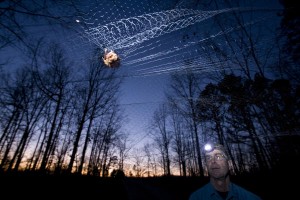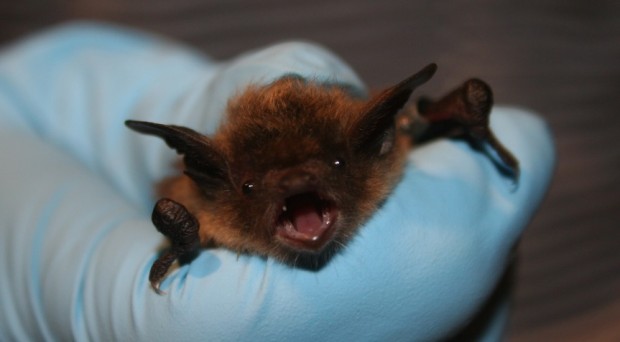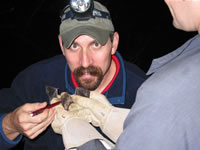How Researchers Are Recording the Sound of a Massive Bat Die-Off
Photo Courtesy of USFWS/Ann Froschauer
This species of Little Brown Bat was once common in the Northeast, but has been devastated by white-nose syndrome.
If you’ve ever tried to evict an unwelcome bat from your home, you know it can be tricky. If you haven’t, imagine trying to coax an agile mouse into a laundry basket. Now imagine that mouse has wings. Now imagine it has wings and sonar.
Chris Corben, a bat expert, doesn’t like the “mice with wings” analogy. He says bats are more like elephants (they have very low birth rates, he explains). But he agrees that they are difficult to catch, and it’s because of that “sonar.”
“You can’t just put a trap up in a field and expect to get anything,” says Corben. “Because of the bats’ echolocation system, they’re remarkably good at avoiding the traps.”
That “echolocation” is the way bats get around. They’re active mostly at night, when they can’t rely on their eyesight. So they send out a little “chirp.” Then they wait for that sound to bounce back at them. It tells them what’s nearby, or where they might find a tasty bug to eat.
It can also alert you to their presence. Corben has invented one of many bat detectors now that identify bats by their sound. The detectors use high powered microphones to capture bat noises, many of them inaudible to humans. That sound is run through a computer program to determine exactly what type of bat is in a given area.
The devices have been used for years by scientists, but are becoming an increasingly important tool as the populations of bats in the U.S. plummets. The reason for that decline is white-nose syndrome. An invasive fungus that has killed millions of bats in the north east.

Photo courtesy of Prf. Lynn Robbins and MSU
Dr. Lynn Robbins at Missouri State University using a mistnet to catch a bat.
“[White-nose] has made previously endangered species even that much more threatened with extinction.” says Mark Ford, a professor at Virginia Tech who does bat research for the US Geological Survey. “And it’s taken very common species — now those species are also endangered of becoming extinct.”
Ford recently co-authored a paper outlining how acoustic bat detection, like the kind used by Corben, can help conservation efforts.
“Our acoustic work before white-nose was somewhat in the realm of pure science,” says Ford. “Now, with so many bats being removed from the landscape, they’re still there, but the detection probability is so low that if someone goes out to mistnet bats (a way of capturing bats), they’re probably going to get skunked.”
That’s a major concern for conservationists, wildlife managers and regulators who still need to know if the bats are there in order to protect them.
“It doesn’t matter if there’s one individual or 1000 individuals,” says Ford, referring to his work with the endangered Indiana bat. “The endangered species act still applies.”
The Sound of a Vanishing Bat
The devices are also helping track the spread of white-nose.
“We’ve had a couple detectors that we’ve had out for over three years when we started learning that white-nose syndrome was heading west to Missouri,” says Lynn Robbins, a biology professor at Missouri State University. “More likely, it has now arrived.”
Robbins says the technique is also in high demand now as the energy industry moves into rural areas to build pipelines and wind turbines and needs to do surveys of local wildlife.
Sometimes, bat detectors reveal a pleasant surprise, like Mark Ford discovered the endangered gray bat in new parts of Georgia.
“Subsequent to our work, personnel from the Georgia Department of Natural Resources were able to net and confirm that endangered species,” says Mark Ford.
More often, researchers say, certain bats are simply going silent. And as white-nose syndrome spreads, it appears certain is that the use of acoustic bat detection will grow with it.
“Employers are after my students,” says Lynn Robbins. “I could have placed probably ten to fifteen graduate students this year because one of the things I do train my students is identification of these endangered species.”


